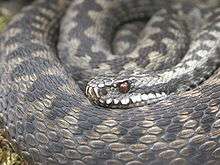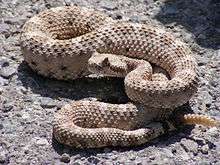Keeled scales

Keeled scales refer to reptile scales that, rather than being smooth, have a ridge down the center that may or may not extend to the tip of the scale,[1] making them rough to the touch. According to Street's (1979) description of European lizards and snakes, in those that have keeled scales the keels are usually stronger in male specimens and are consistently arranged according to the species of reptiles, even though many others do not have them. With European lizards, the dorsal scales are usually well keeled, while those on the flanks are more weakly keeled and those on the belly smooth.[2]
Klauber (1997), describes how the keels on the scales of rattlesnakes are particularly strong mid-dorsally, but gradually weaken on the lateral rows with the ventral scales being smooth. He stated that the function of the keels was uncertain, but that since they reduced shininess, and thus made it easier for the animals to conceal themselves, it afforded them an evolutionary advantage.[3]
Keeled scales scatter light differently from smooth, flat scales. As a result, most reptiles with keeled scales are not shiny: they have a dull, non-reflective appearance. It is therefore possible that keeled scales further improve the camouflage effects already provided by skin coloration, countershading and disruptive patterns.
In some vipers, most notably those of the genus Echis, the lateral scales are not only keeled, but the keels have minute serrations. The snakes use this in a warning/threat display: the body is arranged into a series of parallel C-shaped (counterlooped) coils that they rub together continuously to produce a sizzling sound, rather like water on a hot plate. This method of making sound is called stridulation.[4]
Gallery
-

Keeled scales on Bitis arietans
-

Keeled scales on Vipera berus
-

Keeled scales on Crotalus cerastes
-

Keeled scales on Crotalus atrox
-
Ottoman viper showing typical non-reflective appearance of reptiles with keeled scales
-
.jpg)
Keeled scales on Crotalus horridus
References
- ↑ Campbell JA, Lamar WW. 2004. The Venomous Reptiles of the Western Hemisphere. Comstock Publishing Associates, Ithaca and London. 870 pp. 1500 plates. ISBN 0-8014-4141-2.
- ↑ Street D. 1979. The Reptiles of Northern and Central Europe. London: B.T. Batsford Ltd. 268 pp. ISBN 0-7134-1374-3.
- ↑ Klauber LM. 1997. Rattlesnakes: Their Habitats, Life Histories, and Influence on Mankind. Second Edition. First published in 1956, 1972. University of California Press, Berkeley. ISBN 0-520-21056-5.
- ↑ Mallow D, Ludwig D, Nilson G. 2003. True Vipers: Natural History and Toxinology of Old World Vipers. Malabar, Florida: Krieger Publishing Company. 359 pp. ISBN 0-89464-877-2.
